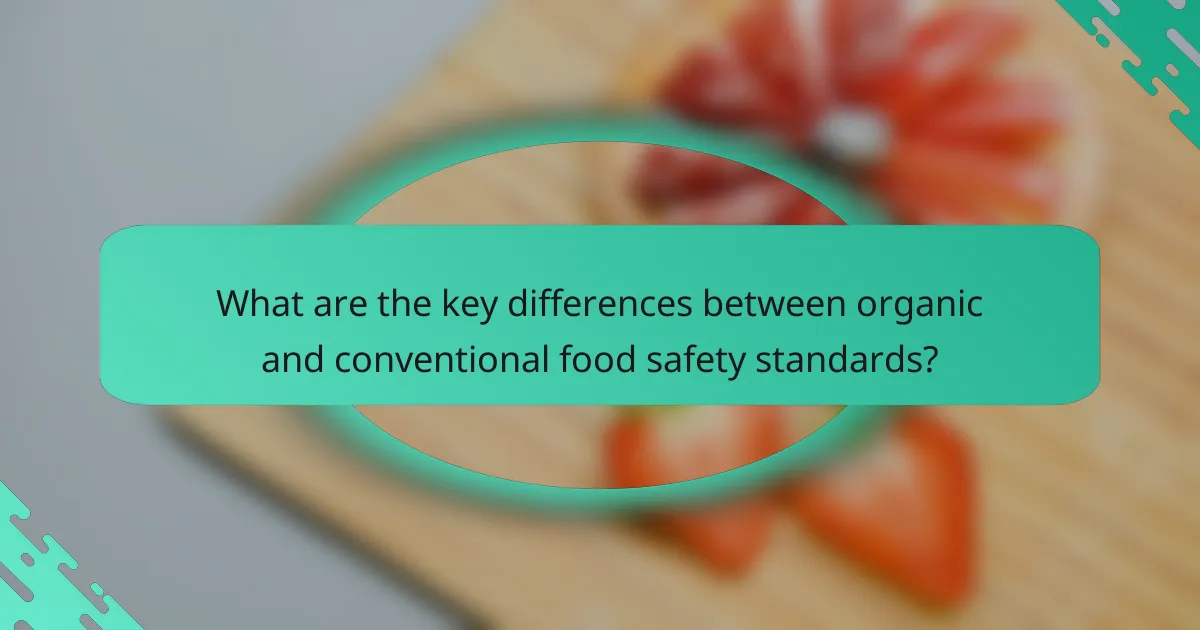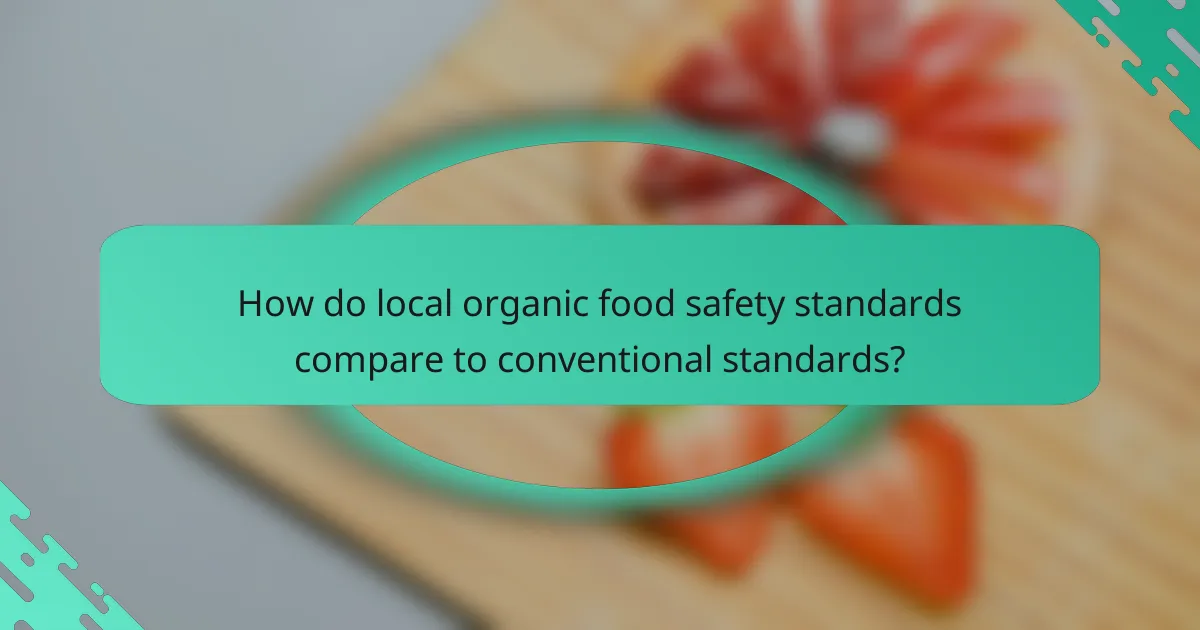The safety standards for organic and conventional food differ significantly, primarily in their regulatory frameworks, permitted substances, and inspection processes. Organic standards prioritize natural practices and impose restrictions on synthetic chemicals, while conventional standards permit a wider array of substances and methods. This divergence impacts farming, processing, and distribution, with organic products often subjected to more rigorous compliance requirements to ensure safety and quality.

What are the key differences between organic and conventional food safety standards?
Organic and conventional food safety standards differ primarily in their regulatory frameworks, allowed substances, and inspection processes. Organic standards emphasize natural practices and restrict synthetic chemicals, while conventional standards allow a broader range of substances and methods.
Regulatory frameworks
Organic food is regulated under specific national and international standards, such as the USDA Organic in the United States and the EU Organic Certification in Europe. These frameworks require compliance with stringent guidelines that govern production, processing, and labeling.
Conventional food safety standards are typically governed by broader food safety regulations, such as the FDA regulations in the U.S. or the Food Safety Authority in Europe. These regulations focus on ensuring food is safe for consumption but allow more flexibility in production methods.
Testing and inspection protocols
Organic farms and facilities are subject to regular inspections by accredited certifying agents to ensure compliance with organic standards. These inspections often include soil testing, crop management reviews, and traceability assessments.
Conventional food producers also undergo inspections, but the frequency and rigor can vary significantly. Inspections may focus more on end-product safety and less on the agricultural practices used to produce the food.
Allowed substances and additives
Organic standards prohibit the use of synthetic pesticides, herbicides, and fertilizers, promoting natural alternatives instead. This restriction aims to minimize chemical residues in organic products.
In contrast, conventional food production allows a wide range of synthetic substances, including certain pesticides and food additives. This flexibility can enhance crop yields but may raise concerns about chemical exposure for consumers.
Labeling requirements
Organic products must meet specific labeling requirements, including the use of the USDA Organic seal or equivalent certification marks in other regions. Labels must clearly indicate the percentage of organic ingredients, ensuring transparency for consumers.
Conventional food labeling is less regulated regarding ingredient sourcing and production methods. While nutritional information is mandatory, claims about farming practices are often less stringent and can vary widely.
Consumer safety measures
Organic food safety measures prioritize consumer health by limiting exposure to harmful chemicals and promoting sustainable farming practices. Consumers often perceive organic products as healthier due to these stringent safety standards.
Conventional food safety measures focus on preventing contamination and ensuring food is safe to eat. This includes monitoring for pathogens and chemical residues, but the broader range of allowed substances can lead to varying perceptions of safety among consumers.

How do local organic food safety standards compare to conventional standards?
Local organic food safety standards often emphasize stricter regulations and practices compared to conventional standards. These differences can affect everything from farming practices to processing and distribution, ensuring that organic products meet higher safety and quality benchmarks.
State-specific regulations
Each state in the U.S. has its own set of regulations governing organic and conventional food safety. Organic standards are typically more stringent, requiring certification from accredited bodies. For example, states may mandate specific practices regarding pesticide use, soil management, and livestock treatment that exceed federal guidelines.
In contrast, conventional food safety regulations may focus more on general safety practices without the same level of scrutiny on inputs. This can lead to variations in food safety outcomes depending on the state, making it essential for producers to understand local laws.
Local certification processes
Certification for organic food involves a detailed process that varies by region. Producers must submit an application, undergo inspections, and maintain records to demonstrate compliance with organic standards. This process can take several months and requires ongoing adherence to regulations.
Conventional food producers may not face such rigorous certification requirements, often only needing to comply with general food safety laws. This difference can impact the time and resources needed to bring products to market, with organic producers typically investing more upfront in compliance.
Regional compliance challenges
Organic food producers often encounter unique compliance challenges based on regional factors. For instance, access to organic inputs, such as seeds and fertilizers, can be limited in certain areas, complicating adherence to organic standards. Additionally, weather conditions and local pest pressures may necessitate different practices that could conflict with organic regulations.
Conventional producers may face fewer barriers in sourcing materials but must still navigate various safety regulations that can vary significantly by region. Understanding these challenges is crucial for both organic and conventional producers to ensure compliance and maintain product safety.

What are the compliance requirements for organic food producers?
Organic food producers must adhere to strict compliance requirements that ensure their products meet organic standards. These requirements typically include certification, detailed documentation, and regular inspections to maintain organic integrity.
Certification bodies
Certification bodies are organizations authorized to verify that food producers comply with organic standards. In the United States, the USDA is the primary certifying agency, while in the European Union, various accredited bodies oversee compliance. Producers must select a certifying agency that aligns with their operational region and specific organic standards.
Each certification body has its own procedures and fees, which can vary significantly. It’s essential for producers to understand the requirements of their chosen certifier, including the necessary documentation and timelines for application.
Documentation and record-keeping
Organic food producers are required to maintain comprehensive documentation that tracks all aspects of their farming and production processes. This includes records of inputs used, crop rotations, pest management practices, and sales. Proper record-keeping is crucial for demonstrating compliance during inspections.
Producers should implement a systematic approach to documentation, ensuring that records are organized and easily accessible. Utilizing digital tools can streamline this process, making it easier to update and retrieve information as needed.
Annual inspections
Annual inspections are a mandatory part of the compliance process for organic food producers. During these inspections, certifying agents evaluate the producer’s adherence to organic standards, reviewing documentation and conducting on-site assessments. Inspections typically occur once a year but may be more frequent if issues arise.
Producers should prepare for inspections by ensuring all records are up-to-date and by conducting internal audits to identify potential compliance gaps. Being proactive can help mitigate issues during the official inspection and maintain organic certification.

What are the compliance requirements for conventional food producers?
Conventional food producers must adhere to a variety of compliance requirements to ensure food safety and quality. These standards are primarily set by federal and state regulations, focusing on safe production, handling, and distribution practices.
FDA regulations
The Food and Drug Administration (FDA) establishes key regulations that conventional food producers must follow. These include the Food Safety Modernization Act (FSMA), which emphasizes preventive controls and risk-based approaches to food safety. Producers are required to register with the FDA and comply with Good Manufacturing Practices (GMPs) to ensure food safety throughout the production process.
Producers should also be aware of specific labeling requirements and standards for food additives, which help maintain consumer safety and transparency. Regular inspections and compliance checks by the FDA are essential to ensure adherence to these regulations.
State health department guidelines
Each state has its own health department guidelines that complement federal regulations. These guidelines often include specific requirements related to food handling, storage, and sanitation practices. State regulations can vary significantly, so producers must familiarize themselves with local laws to ensure compliance.
In many cases, state health departments conduct routine inspections and may require food producers to obtain permits or licenses. Understanding these local requirements is crucial for avoiding penalties and ensuring safe food production.
Food safety plans
Conventional food producers are required to develop and implement comprehensive food safety plans. These plans typically include hazard analysis and critical control points (HACCP) to identify and mitigate potential risks throughout the production process. A well-structured food safety plan helps ensure that food products are safe for consumption.
Producers should regularly review and update their food safety plans to reflect any changes in operations or regulations. Training staff on food safety practices and maintaining thorough documentation are also essential components of an effective food safety plan.

What are the benefits of adhering to organic food safety standards?
Adhering to organic food safety standards offers numerous benefits, including enhanced consumer trust and improved environmental sustainability. These standards ensure that food is produced without synthetic pesticides and fertilizers, promoting healthier ecosystems and potentially safer food options.
Improved Consumer Trust
Organic food safety standards help build consumer confidence by ensuring that products are free from harmful chemicals and genetically modified organisms (GMOs). When consumers see organic certification, they often perceive these products as healthier and more environmentally friendly.
Retailers and producers who comply with organic standards can leverage this trust to differentiate their products in a competitive market. This can lead to increased sales and customer loyalty, as consumers are willing to pay a premium for organic items.
Environmental Benefits
Organic farming practices promote biodiversity and reduce pollution by avoiding synthetic chemicals. This not only benefits the soil and water systems but also supports wildlife habitats. By adhering to organic standards, farmers contribute to a more sustainable agricultural system.
Additionally, organic farming often employs crop rotation and other practices that enhance soil health, leading to long-term agricultural sustainability. This can result in better yields over time, despite the initial challenges of transitioning from conventional methods.
Compliance with Regulations
Complying with organic food safety standards is essential for legal market access. In many countries, such as the United States and those in the European Union, organic certification is regulated and requires adherence to specific guidelines. Non-compliance can lead to penalties or loss of certification.
Producers must keep detailed records of their farming practices and undergo regular inspections to maintain their organic status. Understanding these compliance requirements is crucial for anyone looking to enter the organic market.


